Agile Testing Tutorial - What is Agile Testing - Software Testing Tutorial
Introduction to Agile Testing
- An iterative and incremental method that develops during the cooperation between the customer and self establish team is known as Agile Testing.
- In software testing the word agile means that something that can be performed quickly and immediately.
- To test the software product and several modules, a core functional agile team will be setup in an company.
- This implementation of testing makes sure to deliver a high quality product as bugs and defects get deleted in the initial stage of the project itself.

- Agile testing can be created at the beginning of the project with integration between development and testing. It is not a sequential but the continuous process.
- We can use agile testing for testing complicated software in a smarter way which accepts more effective results as compared to the traditional testing procedures.
- The execution of agile testing will help us identify the initial error and elimination, giving better results in less development time and costs.
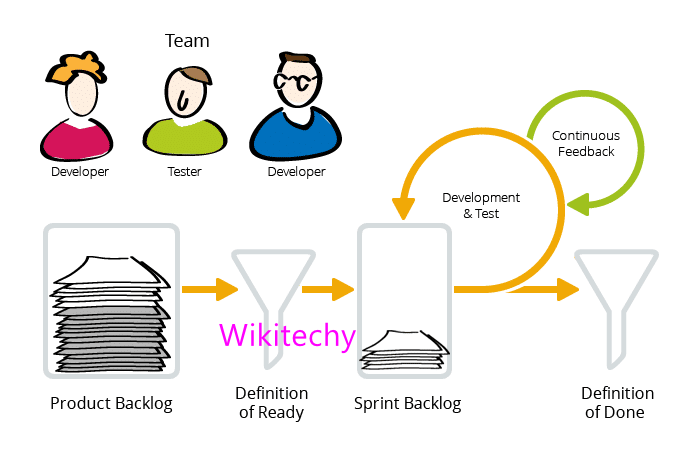
Agile Testing Principles
- Various principles that helps us to increase the software productivity is as below:
- Constant Response
- Continuous Testing
- Less Documentation
- Customer Satisfaction
- Easy and Clean Code
- Involvement of the entire team
- Test Driven
- Quick Feedback.
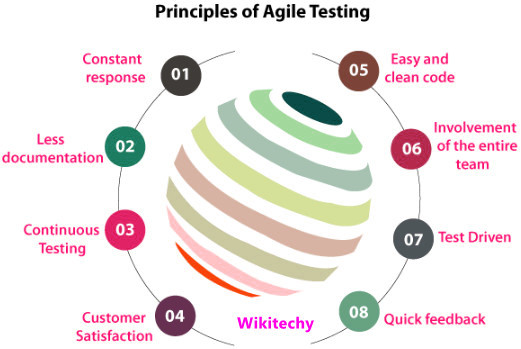
Constant Response
- When we need continuous response or feedback, we can use agile testing. So our product can meet the business needs.
- Through constant feedback and response we can understand the product and business requirement using agile testing.
Less Documentation
- We need less documentation for the execution of agile testing as the team or test engineer use a reuseable specifications or check list.
- The team focuses on test rather than secondary information.
Continuous Testing
- Continuous testing technique is used for the constant improvement of the product which is used by the agile test engineers for executing the test endlessly.
Customer Satisfaction
- Throughout the development process customers are exposed to their product, so customer satisfaction is very important.
- During this phase, customers can easily modify and update the requirements so that the test can be changed as per the requirement.
Easy and Clean code
- If the bugs or defects found by the agile team or the testing team it is fixed in a similar iteration, which gives us easy and clean code.
Involvement of the entire team
- In sdlc testing team is responsible for testing process but in agile testing business analyst and the developers can also test the application.
Test-Driven
- During the implementation phase we can use agile testing which helps us to decrease the development time.
- However, the testing is implemented after implementation or when the software is developed in the traditional process.
Quick response
- Business team is involved in each phase of agile testing, so we can get contiuous feedback which helps us to reduce the time of feedback response on development work.
Read Also
software testing training in chennai , software testing training institute in chennai , free software testing course in chennaiUses of Agile Methodology in Testing
- Advanced dynamic type of testing which is performed regularly throughout every iteration of SDLC by agile test engineers. It is fast and informal testing process.
- If we deliver the software quickly with the best of the attributes, and the customer satisfaction is the primary concern at some stage in the agile testing process.
Agile Testing Methodologies
- When agile testing are executed, the team uses several agile methods which support them to get precise results.
- Some of the effective agile testing methodologies are as follows:
- Test-Driven Development (TDD)
- Behavior Driven Development (BDD)
- Exploratory Testing
- Acceptance Test-Driven Development (ATDD)
- Extreme Programming (XP)
- Session-Based Testing
- Dynamic Software Development Method (DSDM)
- Crystal Methodologies

Test-Driven Development (TDD)
- The test-driven development method begins with the test itself. As the name suggests, the TDD varies upon the repetition of the development cycle.
- Creation of unit test case is the first step of development life cycle. In the next phase we will be designing the code to fit the test case in order to execute the test cases.
- Till the unit test passes the whole code is designed. Test driven development is executed by using the automated testing tools and implement on units and components of the code.
Behavior-Driven Development (BDD)
- Behaviour driven development is a method in agile testing.
- Communication between the project stake holders to facilitate the members adequately and understand all the components before the development process begins.
- Same rules are followed for TDD and ATDD. Based on the test case design coding is developed in the testing methodology.
- The main purpose is to emphasize the identification of business needs and outputs. And the code being developed should be consistent to the business output.
- Below steps are followed in Behaviour driven development
- Describe the behavior.
- Generating the test case.
- Writing code as per the test case is specified.
- Continuing the process until the code passes the test case.
Exploratory Testing
- To create the most effective software and fundamental freedom to explore the code, exploratory testing is used.
- We can say that we have done one round of exploratory testing if the requirement is not known.
- Unknown risks that cannot be found from simple testing can be discovered using exploratory testing.
- To explore each aspect of the software functionality, the test engineer creates various test cases, executes different tests, and records the process to learn it and understand its particular flow.
- Following are the below steps to perform exploratory testing.
- Exploring the application in all possible ways
- Understanding the flow of the application
- Preparing a test document
- Testing the application
Acceptance Test-Driven Development (ATDD)
- Agile testing has another method which is known as Acceptance Test-Driven Development(ATDD). In this approach team members different view point is emphasized on customers requirement.
- Members of development, testing and customer come together in order to develop the acceptance test from the customer`s perspective.
- In Acceptance Test Driven Development, the code is acquired along with the developed acceptance test case.
- It is a very focussed customer centered methodology. The primary objective of using ATDD is to develop a program based on user`s view.
Extreme Programming (XP)
- The next and most significant method in agile technology is Extreme Programming and it is referred to as XP.
- If there is a frequent changes in user requirements then extreme programming methodology can be used.
- Extreme programming is also customer centric methodology.
- Xp helps us to deliver a quality product which meets the customer requirements that are made clear throughout the process of development and testing.
Session-Based Testing
- Next method in agile testing is session based testing.Values obtained from the exploratory testing is used in this testing.
- Exploratory testing is done suddenly without any planning whereas the session based testing is done based on certain structure.
- It is used to help us identify the hidden bugs and defects in the particular software.
- Here tests are executed in continuous sessions where test engineers report the tests which took place throughout the entire process.
Agile Test Plan
- For every plan agile test plan is created and updated as compared to the waterfall model. Agile test plan also contains test environments, test data requirements, test results and infrastructure.
- The agile test plans emphasize the following:
- Testing Scope : Scope covers sprint goals, scope ot test, and test coverage in the test will be implemented
- Performance and Load Testing: Different testing methods and procedures are specified here.
- Types of testing or levels as per the feature's complexity: Determines the types of testing or levels of testing that can be used. It also provides the data and configurations for the test and environment in which the test will be executed.
- Mitigation or Risks Plan: To overcome the risks or issues a backup plan is prepared and defined. During the current release it helps to identify the challenges which might arise at the time of testing.
- Deliverables and Milestones: Milestones and deliverables of the test are set as per the customer`s perspective.
- Infrastructure Consideration: Infrastructure is governed to perform the tests.
- Resourcing: Tasks are list out and the occurrencec of tests are defined the number of times the test needs to be executed.
- Establish the New functionalities which are being tested.
Agile Testing Strategies
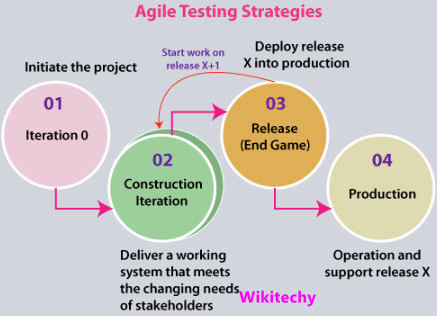
- 4 types of agile testing strategy approach that helps to enhance our product quality.
- Iteration 0
- Construction iteration
- Release End Game or Transition Phase
- Production
Iteration 0
- Iteration 0 is the first approach of agile testing. Here setting up of preliminary testing like finding people for testing, establishing testing tools, preparing resources or usability testing is performed.
- In Iteration 0, the below steps are accomplished.
- Here business case, boundry situations and the project scope is verified.
- The use cases and the important requirements that determine the strategic trade-offs are summarised in this iteration.
- Initial project and cost valuation is planned. Risk is detected.
- More than one candidate designs are outlined here.
Construction Iteration
- Construction Iteration is the second strategy in agile testing.
- Majority of testing is performed during this approach.
- In order to create an increment of the solution, construction iteration is performed as a set of iterations.
- In other terms, the listed requirement within each iteration is followed by the agile team where most significant business needs or requirements that are left behind to execute them.
- The construction iteration process divided into the following two types of testing:
- Confirmatory Testing - Confirmatory testing is performed to ensure that product meets all the stake holders requirements. Confirmatory testing is further classified into two types of testing, they are
- Agile Acceptance Testing - This type of testing is combination of both functional testing and acceptance testing. Stake holders and development team together execute this testing.
- Developer Testing - This type of testing is combination of both unit testing and integration testing. Here both database schema and application code is validated.
- Investigative Testing - Investigative testing is executed to test deep and identify all the issues that was not able to find in confirmatory testing.
Release End Game or Transition Phase
- Release is the third approach in testing. The main purpose of this approach is to implement the system effectively in production.
- In the end game defect stories will be worked on by the test engineer. At the end of release end game or transition stage the following activities are carried out:
- Individuals are Supported
- End users are trained
- Operational People
- Similarly, it involves some additional activities as well:
- Restoration and Backup activities are performed.
- Product release is marketed
- User activities are documented
- Completion of system
- Last agile testing methodology consists of whole system and acceptance testing. Product should be tested thoroughly in construction iterations to complete the final testing places.
Production
- Once the release stage is completed, the product will be moved to the production stage.
Read Also
core java selenium training , selenium certification course , Best Selenium Course InstituteDifferent Challenges Faced During Agile Testing
- When agile testing is performed, testing team faces some challenges. They are:
- Last-minute modification
- Tools selection
- Lack of documentation
- Repeated modifications in the code
- Limited test coverage
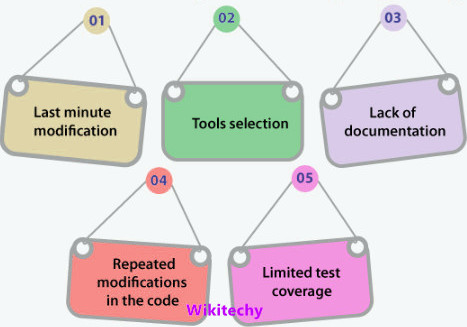
Last-minute Modification
- Primary challenge that are faced in agile testing by the testing team is the last minute modification by the client, which gives less time for the testing team to design and plan, which can affect the product quality.
Tools Selection
- Primary importance in agile testing is to select a good tool because if a wrong tool is selected it can lead to waste of time and money.
- As test execution cycles are reduced we have very less time to perform regression testing.
Lack of Documentation
- Lack of documentation is the frequently faced challenge in agile testing.
- Because of lack of documentation the possibilities of error are more agile, and this creates more impact on the testing team.
Repeated Modifications in the code
- Major challenge faced by the Quality Assurance Team is the repeated modification and updations in the code.
Limited Test Coverage
- Since new features in agile are initiated quickly, it reduces the testing teams time to find if the latest features matches the requirements and address the business suits.
Agile Testing Life Cycle
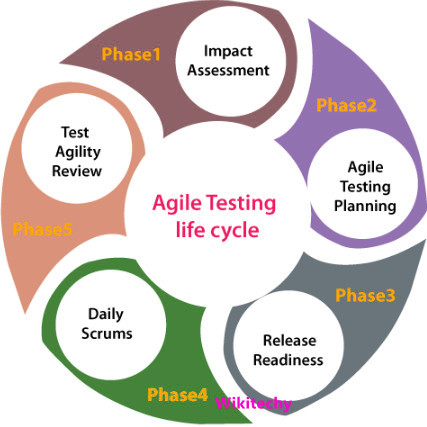
Phase 1: Impact Assessment
- Impact Assessment is the first phase in Agile Testing Life Cycle.
- Here inputs from users and stakeholders are collected to be executed in this phase.
- This phase is also called as feedback phase where support is provided to the test engineers to set the purpose for the next life cycle.
Phase 2: Agile Testing Planning
- The second phase of the Agile testing life cycle is agile testing planning.
- In this phase, a team consists of developers, test engineers, stakeholders, customers, and the end user are formed to plan the testing process schedules, regular meeting, and deliverables.
Phase 3: Release Readiness
- The third phase of agile testing is Release Readiness, where the features that have been created entirely is tested by the test engineers to check which test should go live and which one should go to development phase.
Phase 4: Daily Scrums
- Daily scrums is a phase in which daily morning meeting are conducted to chek on testing and determine the objectives for the day.
- Daily scrums also help test engineers to understand the status of testing, the goals and target of the day are set daily.
Phase 5: Test Agility Review
- The last and final phase of the Agile life cycle is the test agility review.
- This phase consists of weekly meeting with stake holders to check and assess the progress against goals.
- We can say that in order to analyze the progress of the development, these reviews are implemented regulary in development process.
Advantages of Agile Testing
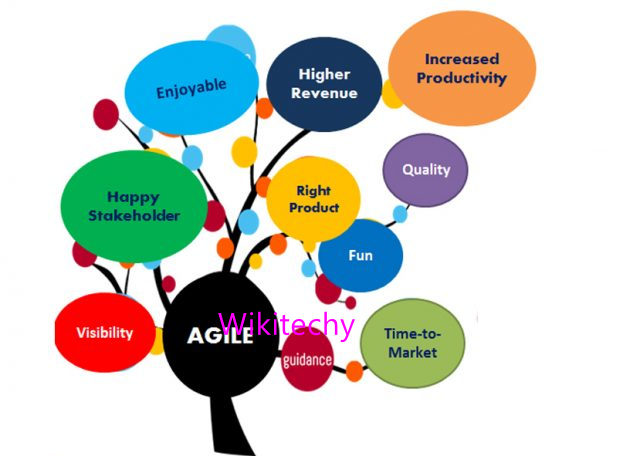
- Software product quality and attribute can be enhanced by getting regular feedback and reviews dirctly from end user.
- Using agile techniques saves lot of time and money and also will make the cost of estimation more transparent.
- Better issues can be found using daily meeting.
- Agile testing needs very less documentation to execute agile testing.
- The main advantage of using agile testing is to reduce errors and enhance the software productivity.
- In agile work load is divided into small parts and helps developer to go off the track, so that we will get more minor inconsistencies and higher efficiency.
Disadvantage of Agile Testing
- Project failure will be a major disadvantage if two or more member leave the job.
- We need determination when performing any testing to test the application or software and becomes inconsistent for testing team.
- Predicting the expected result will be difficult because there is no or less documentation which leads to explicit conditions and requirements.
- Sometimes, it leads us to introduce new bugs in the system because the bug fixes, modifications, and releases repeatedly happen in agile testing.
